Structure and Formation of Z-DNA and Z-RNA
Abstract
1. Introduction
2. Structural Characteristics of the Z-Conformation
2.1. General Properties of a Left-Handed Helix
2.2. The Z-Conformation Is Supported by Two Distinct Dinucleotide Steps
2.3. Phosphate Conformations Are Variable for the CpG Step
2.4. The Major and Minor Grooves of the Z-Conformation
3. Formation and Stability of Z-conformations
3.1. Sequences That Can Easily Adopt the Z-conformation
3.2. Purines Are More Likely to Flip to the Syn Conformation
3.3. The Role of Hydration on the Stabilization of the Z-Conformation
3.3.1. N2 Amino-Facilitated Water Networks Help Stabilize the Z-Conformation
3.3.2. O2 Groups of Pyrimidines Contribute to the Hydration of the Minor Groove
3.3.3. Solvation Patterns at the Major Groove Surface
4. Chemical Conditions That Stabilize the Z-Conformation
4.1. Covalent Modifications Affecting the Stability of the Z-Conformation
4.1.1. Chemical Modifications at Pyrimidine C5 Promote Z-DNA, but Not Z-RNA
4.1.2. Any Modification at C8 Sterically Promotes the Z-Conformation
4.2. Salts, Solvents, and Other Osmolytes
4.2.1. Electrostatic Contributions to the Adoption of a Z-Conformation
4.2.2. Hofmeister Ions and Z-Conformation Stability
4.2.3. Examples of Direct Ion Binding
4.2.4. Promotion of the Z-Conformation through Osmotic Pressure
5. Energetics of Z-Formation
5.1. Inherent Differences of Sugar Puckers for Ribose and Deoxyribose
5.2. Energetics of the A-to-Z and B-to-Z Transitions
5.3. Energies of Z-Formation Depends on Sequence Context
6. Junctions between Right- and Left-Handed Segments
6.1. Z-DNA and Z-RNA Adopt B-Z, A-Z, and Z-Z Junctions
6.2. A-Z and B-Z Junctions Contribute Energetically to Z-Conformation Adoption
7. Outlook
Funding
Acknowledgments
Conflicts of Interest
References
- Wang, A.H.J.; Quigley, G.J.; Kolpak, F.J.; Crawford, J.L.; Van Boom, J.H.; Van Der Marel, G.; Rich, A. Molecular Structure of a Left-Handed Double Helical DNA Fragment at Atomic Resolution. Nature 1979, 282, 680–686. [Google Scholar] [CrossRef] [PubMed]
- Watson, J.D.; Crick, F.H.C. Molecular Structure of Nucleic Acids: A Structure for Deoxyribose Nucleic Acid. Nature 1953, 171, 737–738. [Google Scholar] [CrossRef] [PubMed]
- Hall, K.; Cruz, P.; Tinoco, I.; Jovin, T.M.; Van De Sande, J.H. “Z-RNA”—A Left-Handed RNA Double Helix. Nature 1984, 311, 584–586. [Google Scholar] [CrossRef]
- Davis, P.W.; Adamiak, R.W.; Tinoco, I., Jr. Z-RNA: The Solution NMR Structure of r(CGCGCG). Biopolymers 1990, 29, 109–122. [Google Scholar] [CrossRef] [PubMed]
- Herbert, A.; Alfken, J.; Kim, Y.G.; Mian, I.S.; Nishikura, K.; Rich, A. A Z-DNA Binding Domain Present in the Human Editing Enzyme, Double-Stranded RNA Adenosine Deaminase. Proc. Natl. Acad. Sci. USA 1997, 94, 8421–8426. [Google Scholar] [CrossRef]
- Kim, Y.G.; Lowenhaupt, K.; Oh, D.B.; Kim, K.K.; Rich, A. Evidence That Vaccinia Virulence Factor E3L Binds to Z-DNA in Vivo: Implications for Development of a Therapy for Poxvirus Infection. Proc. Natl. Acad. Sci. USA 2004, 101, 1514–1518. [Google Scholar] [CrossRef] [PubMed]
- Schwartz, T.; Rould, M.A.; Lowenhaupt, K.; Herbert, A.; Rich, A. Crystal Structure of the Zα Domain of the Human Editing Enzyme ADAR1 Bound to Left-Handed Z-DNA. Science 1999, 284, 1841–1845. [Google Scholar] [CrossRef] [PubMed]
- Brown, B.A.; Lowenhaupt, K.; Wilbert, C.M.; Hanlon, E.B.; Rich, A. The Zalpha Domain of the Editing Enzyme DsRNA Adenosine Deaminase Binds Left-Handed Z-RNA as Well as Z-DNA. Proc. Natl. Acad. Sci. USA 2000, 97, 13532–13536. [Google Scholar] [CrossRef]
- Popenda, M.; Milecki, J.; Adamiak, R.W. High Salt Solution Structure of a Left-Handed RNA Double Helix. Nucleic Acids Res. 2004, 32, 4044–4054. [Google Scholar] [CrossRef]
- Placido, D.; Brown, B.A.; Lowenhaupt, K.; Rich, A.; Athanasiadis, A. A Left-Handed RNA Double Helix Bound by the Zα Domain of the RNA-Editing Enzyme ADAR1. Structure 2007, 15, 395–404. [Google Scholar] [CrossRef]
- Ravichandran, S.; Subramani, V.K.; Kim, K.K. Z-DNA in the Genome: From Structure to Disease. Biophys. Rev. 2019, 11, 383–387. [Google Scholar] [CrossRef] [PubMed]
- Herbert, A. Z-DNA and Z-RNA in Human Disease. Commun. Biol. 2019, 2, 7. [Google Scholar] [CrossRef] [PubMed]
- Rich, A.; Nordheim, A.; Wang, A.H. The Chemistry and Biology of Left-Handed Z-DNA. Annu. Rev. Biochem. 1984, 53, 791–846. [Google Scholar] [CrossRef] [PubMed]
- Herbert, A.; Rich, A. Left-Handed Z-DNA: Structure and Function. Genetica 1999, 106, 37–47. [Google Scholar] [CrossRef]
- Ho, P.S.; Mooers, B.H. Z-DNA Crystallography. Biopolymers 1997, 14, 65–90. [Google Scholar] [CrossRef]
- Wang, G.; Vasquez, K.M. Z-DNA, an Active Element in the Genome. Front. Biosci. 2007, 12, 4424–4438. [Google Scholar] [CrossRef]
- Makova, K.D.; Weissensteiner, M.H. Noncanonical DNA Structures Are Drivers of Genome Evolution. Trends Genet. 2023. [Google Scholar] [CrossRef]
- Nichols, P.J.; Krall, J.B.; Henen, M.A.; Vögeli, B.; Vicens, Q. Z-RNA Biology: A Central Role in the Innate Immune Response? RNA 2023, 29, rna-079429. [Google Scholar] [CrossRef]
- Jovin, T.M.; Soumpasis, D.M.; Mcintosh, L.P. The Transition between B-DNA and Z-DNA. Annu. Rev. Phys. Chem. 1987, 38, 521–560. [Google Scholar] [CrossRef]
- Fuertes, M.A.; Cepeda, V.; Alonso, C.; Perez, J.M. Molecular Mechanisms for the B-Z Transition in the Example of Poly[d(G-C) x d(G-C)] Polymers. A Critical Review. Chem. Rev. 2006, 106, 2045–2064. [Google Scholar] [CrossRef]
- Arnott, S.; Hukins, D.W. Optimised Parameters for A-DNA and B-DNA. Biochem. Biophys. Res. Commun. 1972, 47, 1504–1509. [Google Scholar] [CrossRef] [PubMed]
- Arnott, S.; Hukins, D.W. Refinement of the Structure of B-DNA and Implications for the Analysis of x-Ray Diffraction Data from Fibers of Biopolymers. J. Mol. Biol. 1973, 81, 93–105. [Google Scholar] [CrossRef] [PubMed]
- Arnott, S.; Hukins, D.W.; Dover, S.D. Optimised Parameters for RNA Double-Helices. Biochem. Biophys. Res. Commun. 1972, 48, 1392–1399. [Google Scholar] [CrossRef]
- Monleon, D.; Esteve, V.; Celda, B. NMR Study of Hexanucleotide d(CCGCGG)2 Containing Two Triplet Repeats of Fragile X Syndrome. Biochem. Biophys. Res. Commun. 2003, 303, 81–90. [Google Scholar] [CrossRef]
- Popenda, M.; Biala, E.; Milecki, J.; Adamiak, R.W. Solution Structure of RNA Duplexes Containing Alternating CG Base Pairs: NMR Study of r(CGCGCG)2 and 2’-O-Me(CGCGCG)2 under Low Salt Conditions. Nucleic Acids Res. 1997, 25, 4589–4598. [Google Scholar] [CrossRef] [PubMed]
- Wolfram, S. Principles of Nucleic Acid Structure, 1st ed.; Springer: New York, NY, USA, 1984. [Google Scholar]
- Narayana, N.; Shamala, N.; Ganesh, K.N.; Viswamitra, M.A. Interaction between the Z-Type DNA Duplex and 1,3-Propanediamine: Crystal Structure of d(CACGTG)2 at 1.2 A Resolution. Biochemistry 2006, 45, 1200–1211. [Google Scholar] [CrossRef]
- Coll, M.; Fita, I.; Lloveras, J.; Subirana, J.A.; Bardella, F.; Huynh-Dinh, T.; Igolen, J. Structure of d(CACGTG), a Z-DNA Hexamer Containing AT Base Pairs. Nucleic Acids Res. 1988, 16, 8695–8705. [Google Scholar] [CrossRef]
- Wang, A.H.; Hakoshima, T.; van der Marel, G.; van Boom, J.H.; Rich, A. AT Base Pairs Are Less Stable than GC Base Pairs in Z-DNA: The Crystal Structure of d(M5CGTAm5CG). Cell 1984, 37, 321–331. [Google Scholar] [CrossRef]
- Zhou, G.W.; Ho, P.S. Stabilization of Z-DNA by Demethylation of Thymine Bases: 1.3-A Single-Crystal Structure of d(M5CGUAm5CG). Biochemistry 1990, 29, 7229–7236. [Google Scholar] [CrossRef]
- Sadasivan, C.; Gautham, N. Sequence-Dependent Microheterogeneity of Z-DNA: The Crystal and Molecular Structures of d(CACGCG).d(CGCGTG) and d(CGCACG).d(CGTGCG). J. Mol. Biol. 1995, 248, 918–930. [Google Scholar] [CrossRef]
- Wang, A.H.; Gessner, R.V.; van der Marel, G.A.; van Boom, J.H.; Rich, A. Crystal Structure of Z-DNA without an Alternating Purine-Pyrimidine Sequence. Proc. Natl. Acad. Sci. USA 1985, 82, 3611–3615. [Google Scholar] [CrossRef] [PubMed]
- Harp, J.M.; Coates, L.; Sullivan, B.; Egli, M. Water Structure around a Left-Handed Z-DNA Fragment Analyzed by Cryo Neutron Crystallography. Nucleic Acids Res. 2021, 49, 4782–4792. [Google Scholar] [CrossRef] [PubMed]
- D’Ascenzo, L.; Leonarski, F.; Vicens, Q.; Auffinger, P. “Z-DNA like” Fragments in RNA: A Recurring Structural Motif with Implications for Folding, RNA/Protein Recognition and Immune Response. Nucleic Acids Res. 2016, 44, 5944–5956. [Google Scholar] [CrossRef] [PubMed]
- Egli, M.; Gessner, R. V Stereoelectronic Effects of Deoxyribose O4’ on DNA Conformation. Proc. Natl. Acad. Sci. USA 1995, 92, 180–184. [Google Scholar] [CrossRef]
- Mráziková, K.; Šponer, J.; Mlýnský, V.; Auffinger, P.; Kruse, H. Short-Range Imbalances in the AMBER Lennard-Jones Potential for (Deoxy)Ribose·Nucleobase Lone-Pair·pContacts in Nucleic Acids. J. Chem. Inf. Model. 2021, 61, 5644–5657. [Google Scholar] [CrossRef]
- Berger, I.; Egli, M.; Rich, A. Inter-Strand C-H...O Hydrogen Bonds Stabilizing Four-Stranded Intercalated Molecules: Stereoelectronic Effects of O4’ in Cytosine-Rich DNA. Proc. Natl. Acad. Sci. USA 1996, 93, 12116–12121. [Google Scholar] [CrossRef]
- Desiraju, G.R. The C-H...O Hydrogen Bond: Structural Implications and Supramolecular Design. Acc. Chem. Res. 1996, 29, 441–449. [Google Scholar] [CrossRef]
- Barciszewski, J.; Jurczak, J.; Porowski, S.; Specht, T.; Erdmann, V.A. The Role of Water Structure in Conformational Changes of Nucleic Acids in Ambient and High-Pressure Conditions. Eur. J. Biochem. 1999, 260, 293–307. [Google Scholar] [CrossRef]
- Kruse, H.; Mrazikova, K.; D’Ascenzo, L.; Sponer, J.; Auffinger, P. Short but Weak: The Z-DNA Lone-Pair⋅⋅⋅π Conundrum Challenges Standard Carbon Van Der Waals Radii. Angew. Chem. Int. Ed. 2020, 59, 16553–16560. [Google Scholar] [CrossRef]
- Jain, S.; Zon, G.; Sundaralingam, M. The Potentially Z-DNA-Forming Sequence d(GTGTACAC) Crystallizes as A-DNA. J. Mol. Biol. 1987, 197, 141–145. [Google Scholar] [CrossRef]
- Arnott, S.; Chandrasekaran, R.; Birdsall, D.L.; Leslie, A.G.W.; Ratliff, R.L. Left-Handed DNA Helices. Nature 1980, 283, 743–745. [Google Scholar] [CrossRef] [PubMed]
- Quadrifoglio, F.; Manzini, G.; Yathindra, N. Short Oligodeoxynucleotides with d(G-C)n Sequence Do Not Assume Left-Handed Conformation in High Salt Conditions. J. Mol. Biol. 1984, 175, 419–423. [Google Scholar] [CrossRef] [PubMed]
- Ban, C.; Ramakrishnan, B.; Sundaralingam, M. Crystal Structure of the Self-Complementary 5’-Purine Start Decamer d(GCGCGCGCGC) in the Z-DNA Conformation. I. Biophys. J. 1996, 71, 1215–1221. [Google Scholar] [CrossRef] [PubMed]
- Roschdi, S.; Yan, J.; Nomura, Y.; Escobar, C.A.; Petersen, R.J.; Bingman, C.A.; Tonelli, M.; Vivek, R.; Montemayor, E.J.; Wickens, M.; et al. An Atypical RNA Quadruplex Marks RNAs as Vectors for Gene Silencing. Nat. Struct. Mol. Biol. 2022, 29, 1113–1121. [Google Scholar] [CrossRef]
- Gessner, R.V.; Quigley, G.J.; Wang, A.H.; van der Marel, G.A.; van Boom, J.H.; Rich, A. Structural Basis for Stabilization of Z-DNA by Cobalt Hexaammine and Magnesium Cations. Biochemistry 1985, 24, 237–240. [Google Scholar] [CrossRef]
- Schneider, B.; Ginell, S.L.; Jones, R.; Gaffney, B.; Berman, H.M. Crystal and Molecular Structure of a DNA Fragment Containing a 2-Aminoadenine Modification: The Relationship between Conformation, Packing, and Hydration in Z-DNA Hexamers. Biochemistry 1992, 31, 9622–9628. [Google Scholar] [CrossRef]
- Tanaka, Y.; Fujii, S.; Hiroaki, H.; Sakata, T.; Tanaka, T.; Uesugi, S.; Tomita, K.; Kyogoku, Y. A’-Form RNA Double Helix in the Single Crystal Structure of r(UGAGCUUCGGCUC). Nucleic Acids Res. 1999, 27, 949–955. [Google Scholar] [CrossRef]
- Luo, Z.; Dauter, M.; Dauter, Z. Phosphates in the Z-DNA Dodecamer Are Flexible, but Their P-SAD Signal Is Sufficient for Structure Solution. Acta Crystallogr. D Biol. Crystallogr. 2014, 70, 1790–1800. [Google Scholar] [CrossRef]
- Pohl, F.M.; Jovin, T.M. Salt-Induced Co-Operative Conformational Change of a Synthetic DNA: Equilibrium and Kinetic Studies with Poly (DG-DC). J. Mol. Biol. 1972, 67, 375–396. [Google Scholar] [CrossRef]
- Ho, P.S.; Ellison, M.J.; Quigley, G.J.; Rich, A. A Computer Aided Thermodynamic Approach for Predicting the Formation of Z-DNA in Naturally Occurring Sequences. EMBO J. 1986, 5, 2737–2744. [Google Scholar] [CrossRef]
- Peticolas, W.L.; Wang, Y.; Thomas, G.A. Some Rules for Predicting the Base-Sequence Dependence of DNA Conformation. Proc. Natl. Acad. Sci. USA 1988, 85, 2579–2583. [Google Scholar] [CrossRef] [PubMed]
- Wang, Y.; Thomas, G.A.; Peticolas, W.L. Sequence Dependent Conformations of Oligomeric DNA’s in Aqueous Solutions and in Crystals. J. Biomol. Struct. Dyn. 1987, 5, 249–274. [Google Scholar] [CrossRef] [PubMed]
- Ho, P.S.; Frederick, C.A.; Quigley, G.J.; van der Marel, G.A.; van Boom, J.H.; Wang, A.H.; Rich, A. GT Wobble Base-Pairing in Z-DNA at 1.0 A Atomic Resolution: The Crystal Structure of d(CGCGTG). EMBO J. 1985, 4, 3617–3623. [Google Scholar] [CrossRef]
- Brown, T.; Kneale, G.; Hunter, W.N.; Kennard, O. Structural Characterisation of the Bromouracil.Guanine Base Pair Mismatch in a Z-DNA Fragment. Nucleic Acids Res. 1986, 14, 1801–1809. [Google Scholar] [CrossRef] [PubMed]
- Schneider, B.; Cohen, D.M.; Schleifer, L.; Srinivasan, A.R.; Olson, W.K.; Berman, H.M. A Systematic Method for Studying the Spatial Distribution of Water Molecules around Nucleic Acid Bases. Biophys. J. 1993, 65, 2291–2303. [Google Scholar] [CrossRef]
- Schneider, B.; Patel, K.; Berman, H.M. Hydration of the Phosphate Group in Double-Helical DNA. Biophys. J. 1998, 75, 2422–2434. [Google Scholar] [CrossRef]
- Rhodes, L.M.; Schimmel, P.R. Nanosecond Relaxation Processes in Aqueous Mononucleoside Solutions. Biochemistry 1971, 10, 4426–4433. [Google Scholar] [CrossRef]
- Hemmes, P.R.; Oppenheimer, L.; Jordan, F. Ultrasonic Relaxation Evaluation of the Thermodynamics of Syn-Anti Glycosidic Isomerization in Adenosine. J. Am. Chem. Soc. 1974, 96, 6023–6026. [Google Scholar] [CrossRef]
- Segers-Nolten, G.M.J.; Sijtsema, N.M.; Otto, C. Evidence for Hoogsteen GC Base Pairs in the Proton-Induced Transition from Right-Handed to Left-Handed Poly(DG-DC)·poly(DG-DC). Biochemistry 1997, 36, 13241–13247. [Google Scholar] [CrossRef]
- Haschemeyer, A.E.; Rich, A. Nucleoside Conformations: An Analysis of Steric Barriers to Rotation about the Glycosidic Bond. J. Mol. Biol. 1967, 27, 369–384. [Google Scholar] [CrossRef]
- Foloppe, N.; MacKerell, A.D. Contribution of the Phosphodiester Backbone and Glycosyl Linkage Intrinsic Torsional Energetics to DNA Structure and Dynamics. J. Phys. Chem. B 1999, 103, 10955–10964. [Google Scholar] [CrossRef]
- Foloppe, N.; Hartmann, B.; Nilsson, L.; MacKerell, A.D., Jr. Intrinsic Conformational Energetics Associated with the Glycosyl Torsion in DNA: A Quantum Mechanical Study. Biophys. J. 2002, 82, 1554–1569. [Google Scholar] [CrossRef] [PubMed]
- Feigon, J.; Wang, A.H.; van der Marel, G.A.; van Boom, J.H.; Rich, A. Z-DNA Forms without an Alternating Purine-Pyrimidine Sequence in Solution. Science 1985, 230, 82–84. [Google Scholar] [CrossRef] [PubMed]
- Eichman, B.F.; Schroth, G.P.; Basham, B.E.; Ho, P.S. The Intrinsic Structure and Stability of Out-of-Alternation Base Pairs in Z-DNA. Nucleic Acids Res. 1999, 27, 543–550. [Google Scholar] [CrossRef] [PubMed]
- Schroth, G.P.; Kagawa, T.F.; Ho, P.S. Structure and Thermodynamics of Nonalternating C.G Base Pairs in Z-DNA: The 1.3-A Crystal Structure of the Asymmetric Hexanucleotide d(M5CGGGm5CG).d(M5CGCCm5CG). Biochemistry 1993, 32, 13381–13392. [Google Scholar] [CrossRef] [PubMed]
- Olson, W.K. Syn-Anti Effects on the Spatial Configuration of Polynucleotide Chains. Biopolymers 1973, 12, 1787–1814. [Google Scholar] [CrossRef]
- Yathindra, N.; Sundaralingam, M. Conformational Studies on Guanosine Nucleotides and Polynucleotides. The Effect of the Base on the Glycosyl and Backbone Conformations. Biopolymers 1973, 12, 2075–2082. [Google Scholar] [CrossRef]
- Son, T.D.; Guschlbauer, W.; Gueron, M. Flexibility and Conformations of Guanosine Monophosphates by the Overhauser Effect. J. Am. Chem. Soc. 1972, 94, 7903–7911. [Google Scholar] [CrossRef]
- Dauter, Z.; Adamiak, D.A. Anomalous Signal of Phosphorus Used for Phasing DNA Oligomer: Importance of Data Redundancy. Acta Crystallogr. D Biol. Crystallogr. 2001, 57, 990–995. [Google Scholar] [CrossRef]
- Dang, L.X.; Pearlman, D.A.; Kollman, P.A. Why Do A.T Base Pairs Inhibit Z-DNA Formation? Proc. Natl. Acad. Sci. USA 1990, 87, 4630–4634. [Google Scholar] [CrossRef]
- Coll, M.; Wang, A.H.; van der Marel, G.A.; van Boom, J.H.; Rich, A. Crystal Structure of a Z-DNA Fragment Containing Thymine/2-Aminoadenine Base Pairs. J. Biomol. Struct. Dyn. 1986, 4, 157–172. [Google Scholar] [CrossRef] [PubMed]
- Kagawa, T.F.; Howell, M.L.; Tseng, K.; Ho, P.S. Effects of Base Substituents on the Hydration of B- and Z-DNA: Correlations to the B- to Z-DNA Transition. Nucleic Acids Res. 1993, 21, 5978–5986. [Google Scholar] [CrossRef] [PubMed]
- Ellison, M.J.; Feigon, J.; Kelleher, R.J., 3rd; Wang, A.H.; Habener, J.F.; Rich, A. An Assessment of the Z-DNA Forming Potential of Alternating DA-DT Stretches in Supercoiled Plasmids. Biochemistry 1986, 25, 3648–3655. [Google Scholar] [CrossRef] [PubMed]
- Auffinger, P.; Westhof, E. Water and Ion Binding around r(UpA)12 and d(TpA)12 Oligomers—Comparison with RNA and DNA (CpG)12 Duplexes. J. Mol. Biol. 2001, 305, 1057–1072. [Google Scholar] [CrossRef]
- Auffinger, P.; Westhof, E. Water and Ion Binding around RNA and DNA (C.,G) Oligomers. J. Mol. Biol. 2000, 300, 1113–1131. [Google Scholar] [CrossRef]
- Fujii, S.; Wang, A.H.; van der Marel, G.; van Boom, J.H.; Rich, A. Molecular Structure of (M5 DC-DG)3: The Role of the Methyl Group on 5-Methyl Cytosine in Stabilizing Z-DNA. Nucleic Acids Res. 1982, 10, 7879–7892. [Google Scholar] [CrossRef]
- Chevrier, B.; Dock, A.C.; Hartmann, B.; Leng, M.; Moras, D.; Thuong, M.T.; Westhof, E. Solvation of the Left-Handed Hexamer d(5BrC-G-5BrC-G-5 BrC-G) in Crystals Grown at Two Temperatures. J. Mol. Biol. 1986, 188, 707–719. [Google Scholar] [CrossRef]
- Behe, M.; Felsenfeld, G. Effects of Methylation on a Synthetic Polynucleotide: The B--Z Transition in Poly(DG-M5dC).Poly(DG-M5dC). Proc. Natl. Acad. Sci. USA 1981, 78, 1619–1623. [Google Scholar] [CrossRef]
- Klysik, J.; Stirdivant, S.M.; Singleton, C.K.; Zacharias, W.; Wells, R.D. Effects of 5 Cytosine Methylation on the B-Z Transition in DNA Restriction Fragments and Recombinant Plasmids. J. Mol. Biol. 1983, 168, 51–71. [Google Scholar] [CrossRef]
- McIntosh, L.P.; Grieger, I.; Eckstein, F.; Zarling, D.A.; van de Sande, J.H.; Jovin, T.M. Left-Handed Helical Conformation of Poly[d(A-M5C).d(G-T)]. Nature 1983, 304, 83–86. [Google Scholar] [CrossRef]
- Moller, A.; Nordheim, A.; Kozlowski, S.A.; Patel, D.J.; Rich, A. Bromination Stabilizes Poly(DG-DC) in the Z-DNA Form under Low-Salt Conditions. Biochemistry 1984, 23, 54–62. [Google Scholar] [CrossRef] [PubMed]
- Uesugi, S.; Shida, T.; Ikehara, M. Synthesis and Properties of CpG Analogues Containing an 8-Bromoguanosine Residue. Evidence for Z-RNA Duplex Formation. Biochemistry 1982, 21, 3400–3408. [Google Scholar] [CrossRef]
- Nordheim, A.; Hao, W.M.; Wogan, G.N.; Rich, A. Salt-Induced Conversion of B-DNA to Z-DNA Inhibited by Aflatoxin B1. Science 1983, 219, 1434–1436. [Google Scholar] [CrossRef]
- Pohl, F.M. Salt-Induced Transition between Two Double-Helical Forms of Oligo (DC-DG). Cold Spring Harb. Symp. Quant. Biol. 1983, 47, 113–117. [Google Scholar] [CrossRef] [PubMed]
- Preisler, R.S.; Chen, H.H.; Colombo, M.F.; Choe, Y.; Short, B.J., Jr.; Rau, D.C. The B Form to Z Form Transition of Poly(DG-M5dC) Is Sensitive to Neutral Solutes through an Osmotic Stress. Biochemistry 1995, 34, 14400–14407. [Google Scholar] [CrossRef]
- Tinoco, I., Jr.; Davis, P.W.; Hardin, C.C.; Puglisi, J.D.; Walker, G.T.; Wyatt, J. RNA Structure from A to Z. Cold Spring Harb. Symp. Quant. Biol. 1987, 52, 135–146. [Google Scholar] [CrossRef] [PubMed]
- Ross, W.S.; Hardin, C.C.; Tinoco, I., Jr.; Rao, S.N.; Pearlman, D.A.; Kollman, P.A. Effects of Nucleotide Bromination on the Stabilities of Z-RNA and Z-DNA: A Molecular Mechanics/Thermodynamic Perturbation Study. Biopolymers 1989, 28, 1939–1957. [Google Scholar] [CrossRef]
- Shen, F.; Luo, Z.; Liu, H.; Wang, R.; Zhang, S.; Gan, J.; Sheng, J. Structural Insights into RNA Duplexes with Multiple 2′-5′-Linkages. Nucleic Acids Res. 2017, 45, 3537–3546. [Google Scholar] [CrossRef]
- Ghosh, A.; Kar, R.K.; Jana, J.; Saha, A.; Jana, B.; Krishnamoorthy, J.; Kumar, D.; Ghosh, S.; Chatterjee, S.; Bhunia, A. Indolicidin Targets Duplex DNA: Structural and Mechanistic Insight through a Combination of Spectroscopy and Microscopy. ChemMedChem 2014, 9, 2052–2058. [Google Scholar] [CrossRef]
- Ho, P.S.; Kagawa, T.F.; Tseng, K.H.; Schroth, G.P.; Zhou, G.W. Prediction of a Crystallization Pathway for Z-DNA Hexanucleotides. Science 1991, 254, 1003–1006. [Google Scholar] [CrossRef]
- Tavale, S.S.; Sobell, H.M. Crystal and Molecular Structure of 8-Bromoguanosine and 8-Bromoadenosine, Two Purine Nucleosides in the Syn Conformation. J. Mol. Biol. 1970, 48, 109–123. [Google Scholar] [CrossRef] [PubMed]
- Bugg, C.E.; Thewalt, U. Effects of Halogen Substituents on Base Stacking in Nucleic Acid Components: The Crystal Structure of 8-Bromoguanosine. Biochem. Biophys. Res. Commun. 1969, 37, 623–629. [Google Scholar] [CrossRef] [PubMed]
- Xu, Y.; Ikeda, R.; Sugiyama, H. 8-Methylguanosine: A Powerful Z-DNA Stabilizer. J. Am. Chem. Soc. 2003, 125, 13519–13524. [Google Scholar] [CrossRef] [PubMed]
- Pan, F.; Roland, C.; Sagui, C. Ion Distributions around Left- and Right-Handed DNA and RNA Duplexes: A Comparative Study. Nucleic Acids Res. 2014, 42, 13981–13996. [Google Scholar] [CrossRef]
- Bae, S.; Son, H.; Kim, Y.G.; Hohng, S. Z-DNA Stabilization Is Dominated by the Hofmeister Effect. Phys. Chem. Chem. Phys. 2013, 15, 15829–15832. [Google Scholar] [CrossRef]
- Gueron, M.; Demaret, J.; Filoche, M. A Unified Theory of the B-Z Transition of DNA in High and Low Concentrations of Multivalent Ions. Biophys. J. 2000, 78, 1070–1083. [Google Scholar] [CrossRef]
- Son, H.; Bae, S.; Lee, S. A Thermodynamic Understanding of the Salt-Induced B-to-Z Transition of DNA Containing BZ Junctions. Biochem. Biophys. Res. Commun. 2021, 583, 142–145. [Google Scholar] [CrossRef]
- Basu, H.S.; Feuerstein, B.G.; Zarling, D.A.; Shafer, R.H.; Marton, L.J. Recognition of Z-RNA and Z-DNA Determinants by Polyamines in Solution: Experimental and Theoretical Studies. J. Biomol. Struct. Dyn. 1988, 6, 299–309. [Google Scholar] [CrossRef]
- Chatake, T.; Sunami, T. Direct Interactions between Z-DNA and Alkaline Earth Cations, Discovered in the Presence of High Concentrations of MgCl2 and CaCl2. J. Inorg. Biochem. 2013, 124, 15–25. [Google Scholar] [CrossRef]
- Bancroft, D.; Williams, L.D.; Rich, A.; Egli, M. The Low-Temperature Crystal Structure of the Pure-Spermine Form of Z-DNA Reveals Binding of a Spermine Molecule in the Minor Groove. Biochemistry 1994, 33, 1073–1086. [Google Scholar] [CrossRef]
- Balasubramaniyam, T.; Ishizuka, T.; Xiao, C.D.; Bao, H.L.; Xu, Y. 2-O-Methyl-8-Methylguanosine as a Z-Form RNA Stabilizer for Structural and Functional Study of Z-RNA. Molecules 2018, 23, 2572. [Google Scholar] [CrossRef] [PubMed]
- Adamiak, R.W.; Galat, A.; Skalski, B. Salt-Dependent and Solvent-Dependent Conformational Transitions of Ribo-Cgcgcg Duplex. Biochim. Biophys. Acta 1985, 825, 345–352. [Google Scholar] [CrossRef]
- Hofmeister, F. Zur Lehre von Der Wirkung Der Salze. Arch. Für Exp. Pathol. Pharmakol. 1888, 24, 247–260. [Google Scholar] [CrossRef]
- Gibb, B.C. Hofmeister’s Curse. Nat. Chem. 2019, 11, 963–965. [Google Scholar] [CrossRef]
- Kunz, W. Specific Ion Effects in Colloidal and Biological Systems. Curr. Opin. Colloid Interface Sci. 2010, 15, 34–39. [Google Scholar] [CrossRef]
- Pegram, L.M.; Record, M.T., Jr. Thermodynamic Origin of Hofmeister Ion Effects. J. Phys. Chem. B 2008, 112, 9428–9436. [Google Scholar] [CrossRef]
- Zhang, Y.; Cremer, P.S. Chemistry of Hofmeister Anions and Osmolytes. Annu. Rev. Phys. Chem. 2010, 61, 63–83. [Google Scholar] [CrossRef]
- Omta, A.W.; Kropman, M.F.; Woutersen, S.; Bakker, H.J. Negligible Effect of Ions on the Hydrogen-Bond Structure in Liquid Water. Science 2003, 301, 347–349. [Google Scholar] [CrossRef] [PubMed]
- Batchelor, J.D.; Olteanu, A.; Tripathy, A.; Pielak, G.J. Impact of Protein Denaturants and Stabilizers on Water Structure. J. Am. Chem. Soc. 2004, 126, 1958–1961. [Google Scholar] [CrossRef]
- Gurau, M.C.; Lim, S.M.; Castellana, E.T.; Albertorio, F.; Kataoka, S.; Cremer, P.S. On the Mechanism of the Hofmeister Effect. J. Am. Chem. Soc. 2004, 126, 10522–10523. [Google Scholar] [CrossRef]
- Pegram, L.M.; Wendorff, T.; Erdmann, R.; Shkel, I.; Bellissimo, D.; Felitsky, D.J.; Record, M.T. Why Hofmeister Effects of Many Salts Favor Protein Folding but Not DNA Helix Formation. Proc. Natl. Acad. Sci. USA 2010, 107, 7716–7721. [Google Scholar] [CrossRef] [PubMed]
- Collins, K.D. Ions from the Hofmeister Series and Osmolytes: Effects on Proteins in Solution and in the Crystallization Process. Methods 2004, 34, 300–311. [Google Scholar] [CrossRef] [PubMed]
- Dong, V.Q.; Keong, K.K.; Kim, Y.G. Sequence-Dependent Kinetic Behavior of Protein-Induced B- to Z-DNA Transition. Bull. Korean Chem. Soc. 2006, 27, 1071–1074. [Google Scholar] [CrossRef]
- Lee, Y.M.; Kim, H.E.; Park, C.J.; Lee, A.R.; Ahn, H.C.; Cho, S.J.; Choi, K.H.; Choi, B.S.; Lee, J.H. NMR Study on the B-Z Junction Formation of DNA Duplexes Induced by Z-DNA Binding Domain of Human ADAR1. J. Am. Chem. Soc. 2012, 134, 5276–5283. [Google Scholar] [CrossRef]
- Jovin, T.M.; McIntosh, L.P.; Arndt-Jovin, D.J.; Zarling, D.A.; Robert-Nicoud, M.; Van De Sande, J.H.; Jorgenson, K.F.; Eckstein, F. Left-Handed Dna: From Synthetic Polymers to Chromosomes. J. Biomol. Struct. Dyn. 1983, 1, 21–57. [Google Scholar] [CrossRef] [PubMed]
- Gessner, R.V.; Frederick, C.A.; Quigley, G.J.; Rich, A.; Wang, A.H. The Molecular Structure of the Left-Handed Z-DNA Double Helix at 1.0-A Atomic Resolution. Geometry, Conformation, and Ionic Interactions of d(CGCGCG). J. Biol. Chem. 1989, 264, 7921–7935. [Google Scholar] [CrossRef]
- Pan, B.; Ban, C.; Wahl, M.C.; Sundaralingam, M. Crystal Structure of d(GCGCGCG) with 5’-Overhang G Residues. Biophys. J. 1997, 73, 1553–1561. [Google Scholar] [CrossRef] [PubMed]
- Ferreira, J.M.; Sheardy, R.D. Linking Temperature, Cation Concentration and Water Activity for the B to Z Conformational Transition in DNA. Molecules 2018, 23, 1806. [Google Scholar] [CrossRef]
- Thiyagarajan, S.; Rajan, S.S.; Gautham, N. Cobalt Hexammine Induced Tautomeric Shift in Z-DNA: The Structure of d(CGCGCA)*d(TGCGCG) in Two Crystal Forms. Nucleic Acids Res. 2004, 32, 5945–5953. [Google Scholar] [CrossRef]
- Sigel, A.; Sigel, H.; Sigel, R.K.O. Interplay between Metal Ions and Nucleic Acids; Springer: Berlin/Heidelberg, Germany, 2012. [Google Scholar]
- Westhof, E. Water: An Integral Part of Nucleic Acid Structure. Annu. Rev. Biophys. Biophys. Chem. 1988, 17, 125–144. [Google Scholar] [CrossRef]
- Harmouchi, M.; Albiser, G.; Premilat, S. Changes of Hydration during Conformational Transitions of DNA. Eur. Biophys. J. 1990, 19, 87–92. [Google Scholar] [CrossRef] [PubMed]
- Saenger, W.; Hunter, W.N.; Kennard, O. DNA Conformation Is Determined by Economics in the Hydration of Phosphate Groups. Nature 1986, 324, 385–388. [Google Scholar] [CrossRef]
- Shakked, Z.; Guerstein-Guzikevich, G.; Eisenstein, M.; Frolow, F.; Rabinovich, D. The Conformation of the DNA Double Helix in the Crystal Is Dependent on Its Environment. Nature 1989, 342, 456–460. [Google Scholar] [CrossRef]
- Egli, M.; Tereshko, V.; Teplova, M.; Minasov, G.; Joachimiak, A.; Sanishvili, R.; Weeks, C.M.; Miller, R.; Maier, M.A.; An, H.; et al. X-Ray Crystallographic Analysis of the Hydration of A- and B-Form DNA at Atomic Resolution. Biopolymers 1998, 48, 234–252. [Google Scholar] [CrossRef]
- Rozners, E.; Moulder, J. Hydration of Short DNA, RNA and 2’-OMe Oligonucleotides Determined by Osmotic Stressing. Nucleic Acids Res. 2004, 32, 248–254. [Google Scholar] [CrossRef] [PubMed]
- Dickerson, R.E.; Drew, H.R.; Conner, B.N.; Wing, R.M.; Fratini, A.V.; Kopka, M.L. The Anatomy of A-, B-, and Z-DNA. Science 1982, 216, 475–485. [Google Scholar] [CrossRef]
- Foloppe, N.; MacKerell, A.D. Conformational Properties of the Deoxyribose and Ribose Moieties of Nucleic Acids: A Quantum Mechanical Study. J. Phys. Chem. B 1998, 102, 6669–6678. [Google Scholar] [CrossRef]
- Levitt, M.; Warshel, A. Extreme Conformational Flexibility of the Furanose Ring in DNA and RNA. J. Am. Chem. Soc. 1978, 100, 2607–2613. [Google Scholar] [CrossRef]
- Plavee, J.; Tong, W.; Chattopadhyaya, J. How Do the Gauche and Anomeric Effects Drive the Pseudorotational Equilibrium of the Pentofuranose Moiety of Nucleosides. J. Am. Chem. Soc. 1993, 115, 9734–9746. [Google Scholar] [CrossRef]
- Harvey, S.C.; Prabhakaran, M. Ribose Puckering: Structure, Dynamics, Energetics, and the Pseudorotation Cycle. J. Am. Chem. Soc. 1986, 108, 6128–6136. [Google Scholar] [CrossRef]
- Evich, M.; Spring-Connell, A.M.; Germann, M.W. Impact of Modified Ribose Sugars on Nucleic Acid Conformation and Function. Heterocycl. Commun. 2017, 23, 155–165. [Google Scholar] [CrossRef]
- Plavec, J.; Thibaudeau, C.; Chattopadhyaya, J. How Does the 2’-Hydroxy Group Drive the Pseudorotational Equilibrium in Nucleoside and Nucleotide by the Tuning of the 3’-Gauche Effect? J. Am. Chem. Soc. 1994, 116, 6558–6560. [Google Scholar] [CrossRef]
- Chaires, J.B.; Sturtevant, J.M. Thermodynamics of the B to Z Transition in Poly(M5dG-DC). Proc. Natl. Acad. Sci. USA 1986, 83, 5479–5483. [Google Scholar] [CrossRef] [PubMed]
- Klump, H.H.; Jovin, T.M. Formation of a Left-Handed RNA Double Helix: Energetics of the A-Z Transition of Poly[r(G-C)] in Concentrated NaC104Solutions. Biochemistry 1987, 26, 5186–5190. [Google Scholar] [CrossRef]
- Klump, H.H.; Schmid, E.; Wosgien, M. Energetics of Z-DNA Formation in Poly d(A-T), Poly d(G-C), and Poly d(A-C) Poly d(G-T). Nucleic Acids Res. 1993, 21, 2343–2348. [Google Scholar] [CrossRef]
- Irikura, K.K.; Tidor, B.; Brooks, B.R.; Karplus, M. Transition from B to Z DNA: Contribution of Internal Fluctuations to the Configurational Entropy Difference. Science 1985, 229, 571–572. [Google Scholar] [CrossRef]
- Cavailles, J.A.; Neumann, J.M.; Taboury, J.; D’Estaintot, B.L.; Huynh-Dinh, T.; Igolen, J.; Tran-Dinh, S. B, Z Conformations and Mechanism of the z-b-Coil Transitions of the Self-Complementary Deoxy-Hexanucleotide d(C-g-M5c-g-c-g) by ’h-Nmr and Cd Spectroscopy. J. Biomol. Struct. Dyn. 1984, 1, 1347–1371. [Google Scholar] [CrossRef]
- Zhang, T.; Yin, C.; Fedorov, A.; Qiao, L.; Bao, H.; Beknazarov, N.; Wang, S.; Gautam, A.; Williams, R.M.; Crawford, J.C.; et al. ADAR1 Masks the Cancer Immunotherapeutic Promise of ZBP1-Driven Necroptosis. Nature 2022, 606, 594–602. [Google Scholar] [CrossRef]
- Balachandran, S.; Mocarski, E.S. Viral Z-RNA Triggers ZBP1-Dependent Cell Death. Curr. Opin. Virol. 2021, 51, 134–140. [Google Scholar] [CrossRef]
- Koehler, H.; Cotsmire, S.; Zhang, T.; Balachandran, S.; Upton, J.W.; Langland, J.; Kalman, D.; Jacobs, B.L.; Mocarski, E.S. Vaccinia Virus E3 Prevents Sensing of Z-RNA to Block ZBP1-Dependent Necroptosis. Cell Host Microbe 2021, 29, 1266–1276.e5. [Google Scholar] [CrossRef]
- Khuu, P.; Sandor, M.; DeYoung, J.; Ho, P.S. Phylogenomic Analysis of the Emergence of GC-Rich Transcription Elements. Proc. Natl. Acad. Sci. USA 2007, 104, 16528–16533. [Google Scholar] [CrossRef] [PubMed]
- Sung, C.H.; Lowenhaupt, K.; Rich, A.; Kim, Y.G.; Kyeong, K.K. Crystal Structure of a Junction between B-DNA and Z-DNA Reveals Two Extruded Bases. Nature 2005, 437, 1183–1186. [Google Scholar] [CrossRef]
- Kim, D.; Reddy, S.; Kim, D.Y.; Rich, A.; Lee, S.; Kim, K.K.; Kim, Y.G. Base Extrusion Is Found at Helical Junctions between Right- and Left-Handed Forms of DNA and RNA. Nucleic Acids Res. 2009, 37, 4353–4359. [Google Scholar] [CrossRef] [PubMed]
- Nichols, P.J.; Bevers, S.; Henen, M.; Kieft, J.S.; Vicens, Q.; Vögeli, B. Recognition of Non-CpG Repeats in Alu and Ribosomal RNAs by the Z-RNA Binding Domain of ADAR1 Induces A-Z Junctions. Nat. Commun. 2021, 12, 793. [Google Scholar] [CrossRef]
- Kim, D.; Hur, J.; Han, J.H.; Ha, S.C.; Shin, D.; Lee, S.; Park, S.; Sugiyama, H.; Kim, K.K. Sequence Preference and Structural Heterogeneity of BZ Junctions. Nucleic Acids Res. 2018, 46, 10504–10513. [Google Scholar] [CrossRef]
- Subramani, V.K.; Ravichandran, S.; Bansal, V.; Kim, K.K. Chemical-Induced Formation of BZ-Junction with Base Extrusion. Biochem. Biophys. Res. Commun. 2019, 508, 1215–1220. [Google Scholar] [CrossRef] [PubMed]
- De Rosa, M.; De Sanctis, D.; Rosario, A.L.; Archer, M.; Rich, A.; Athanasiadis, A.; Carrondo, M.A. Crystal Structure of a Junction between Two Z-DNA Helices. Proc. Natl. Acad. Sci. USA 2010, 107, 9088–9092. [Google Scholar] [CrossRef]
- Singleton, C.K.; Klysik, J.; Stirdivant, S.M.; Wells, R.D. Left-Handed Z-DNA Is Induced by Supercoiling in Physiological Ionic Conditions. Nature 1982, 299, 312–316. [Google Scholar] [CrossRef]
- Bae, S.; Kim, Y.; Kim, D.; Kim, K.K.; Kim, Y.G.; Hohng, S. Energetics of Z-DNA Binding Protein-Mediated Helicity Reversals in DNA, RNA, and DNA-RNA Duplexes. J. Phys. Chem. B 2013, 117, 13866–13871. [Google Scholar] [CrossRef]
- Watson, J.D.; Crick, F.H. Molecular Structure of Nucleic Acids: A Structure for Deoxyribose Nucleic Acid. Am. J. Psychiatry 2003, 160, 623–624. [Google Scholar] [CrossRef]
- Nakamura, Y.; Fujii, S.; Urata, H.; Uesugi, S.; Ikehara, M.; Tomita, K. Crystal Structure of a Left-Handed RNA Tetramer, r(C-Br8G)2. Nucleic Acids Symp. Ser. 1985, 29–32. [Google Scholar]
- Teng, M.K.; Liaw, Y.C.; van der Marel, G.A.; van Boom, J.H.; Wang, A.H. Effects of the O2’ Hydroxyl Group on Z-DNA Conformation: Structure of Z-RNA and (AraC)-[Z-DNA]. Biochemistry 1989, 28, 4923–4928. [Google Scholar] [CrossRef] [PubMed]
- Sheardy, R.D.; Suh, D.; Kurzinsky, R.; Doktycz, M.J.; Benight, A.S.; Chaires, J.B. Sequence Dependence of the Free Energy of B-Z Junction Formation in Deoxyoligonucleotides. J. Mol. Biol. 1993, 231, 475–488. [Google Scholar] [CrossRef] [PubMed]

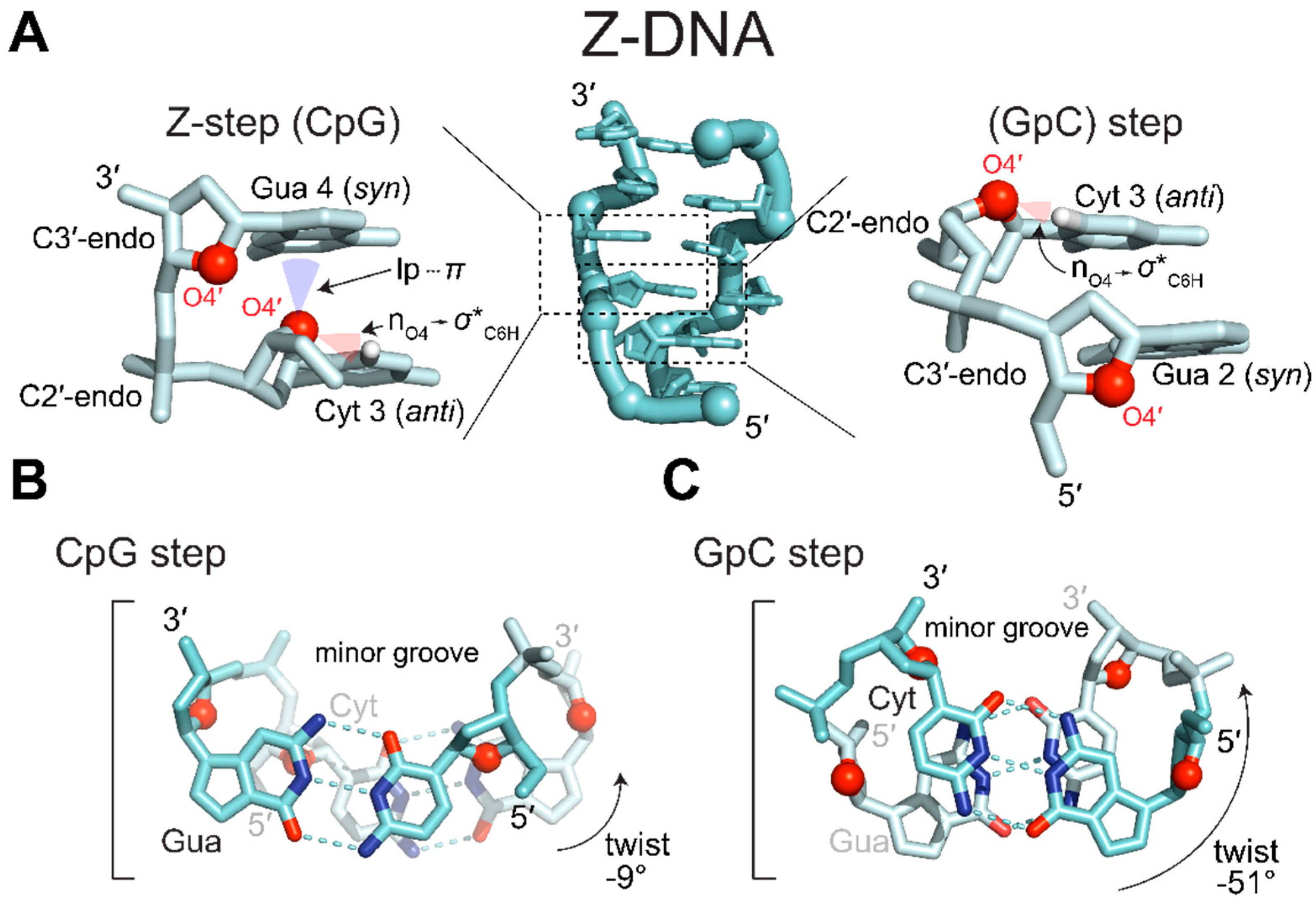
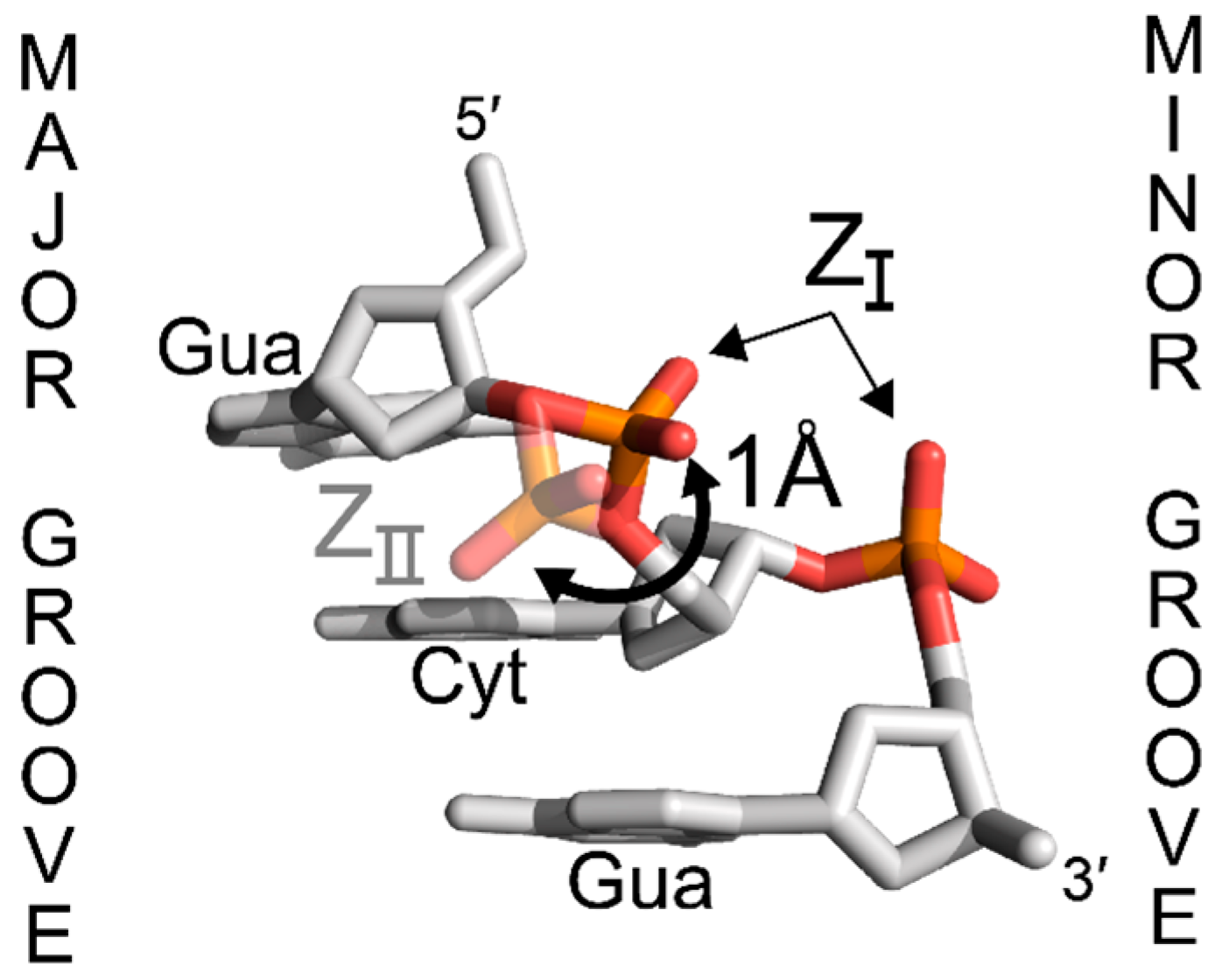
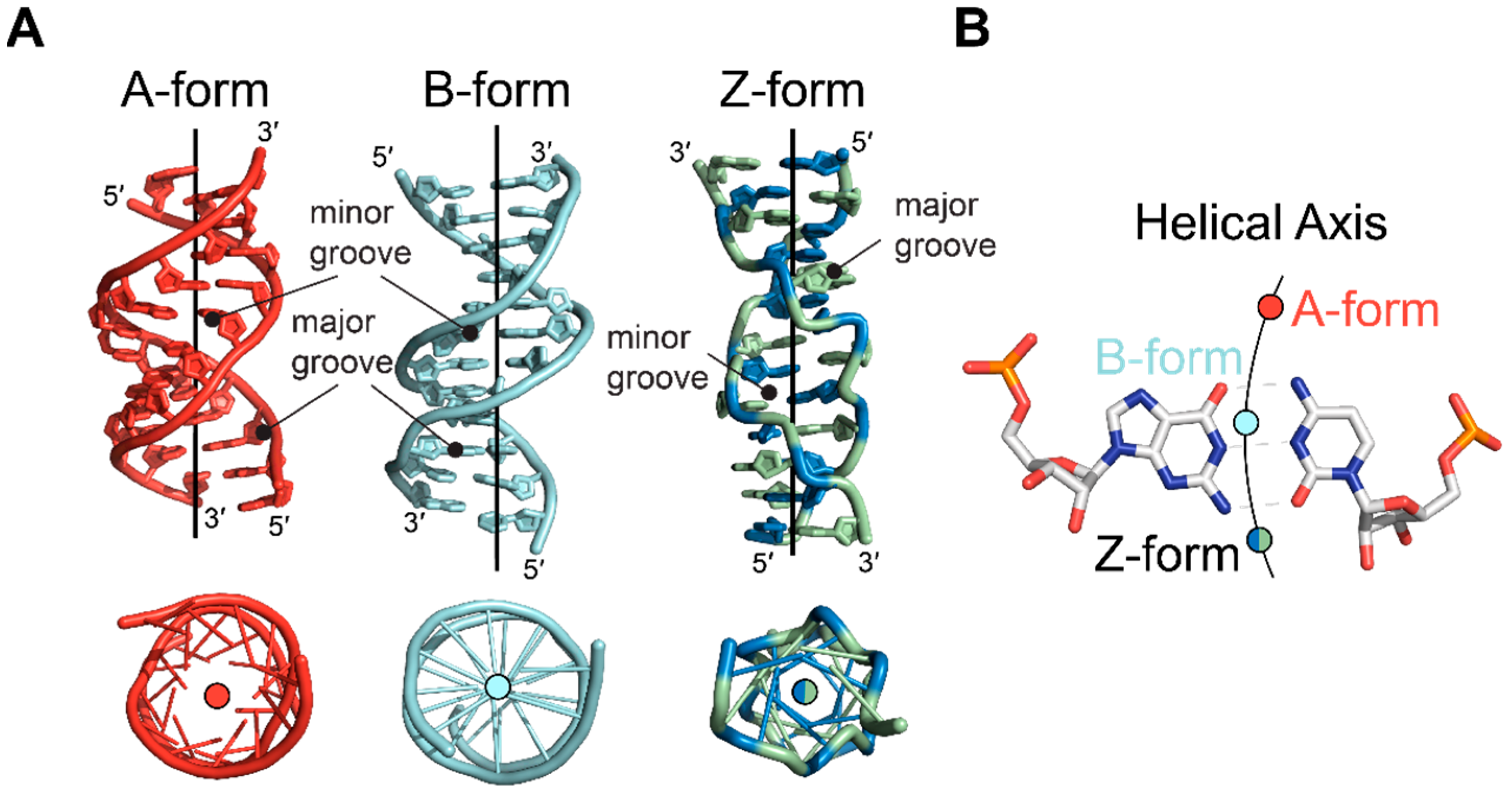






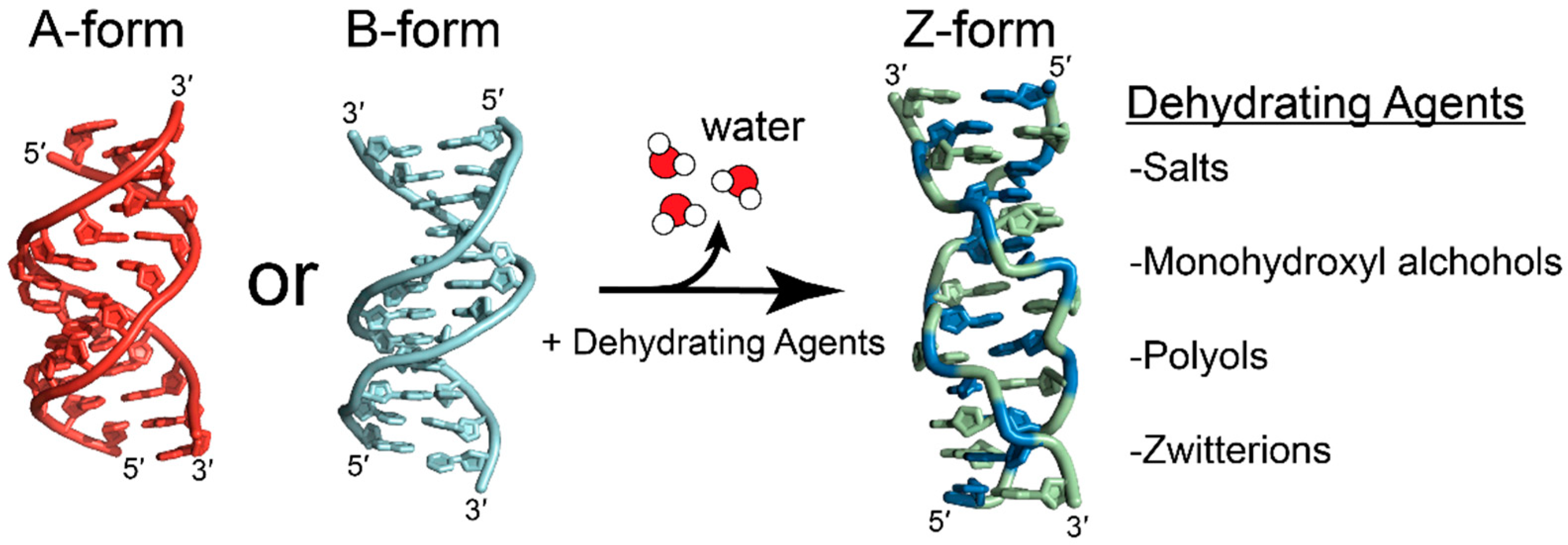
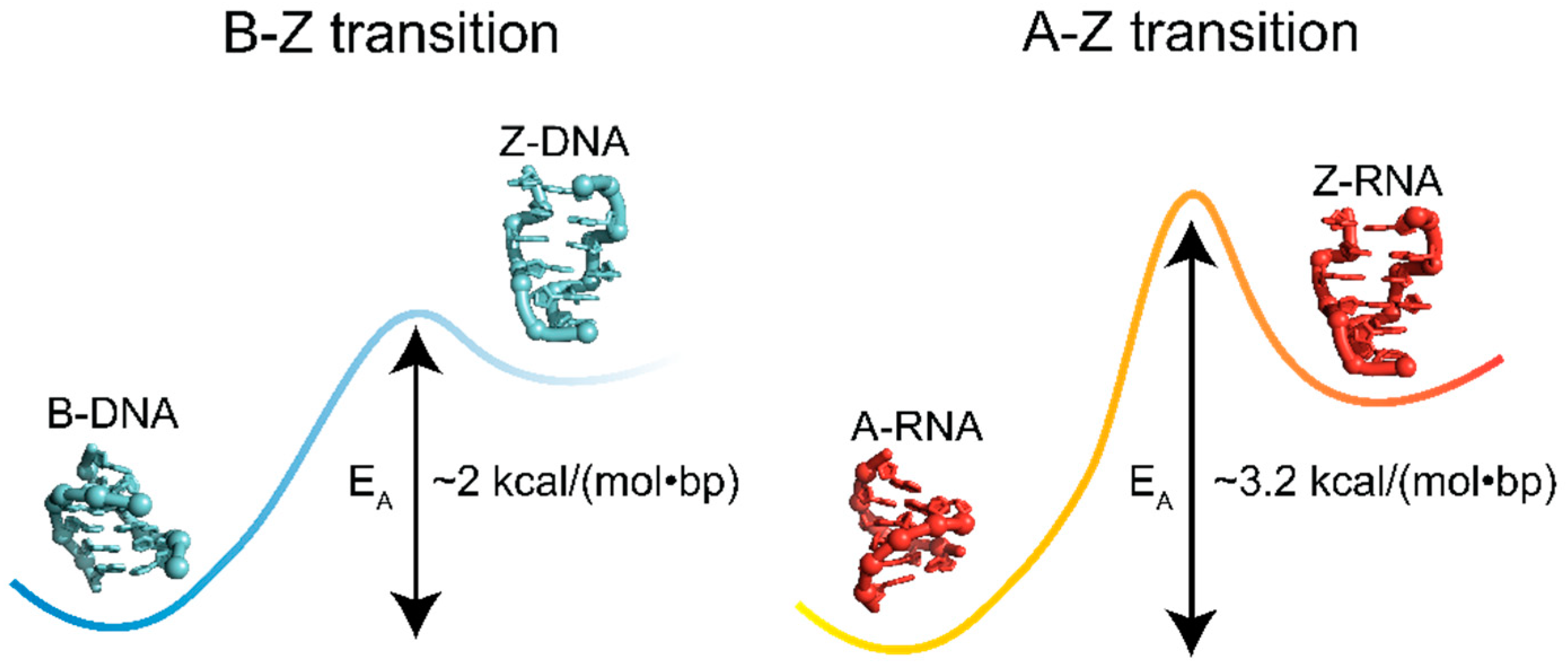
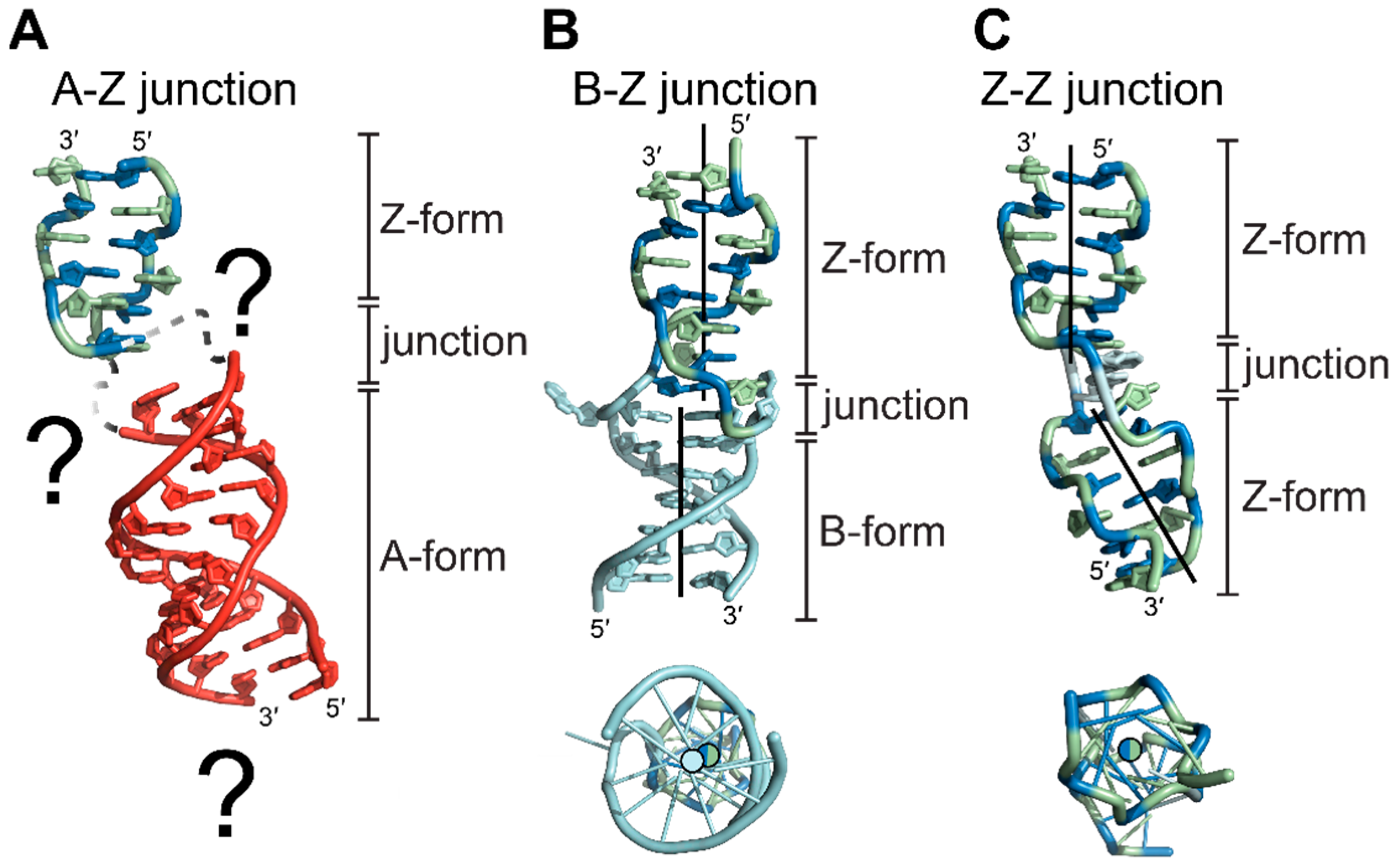
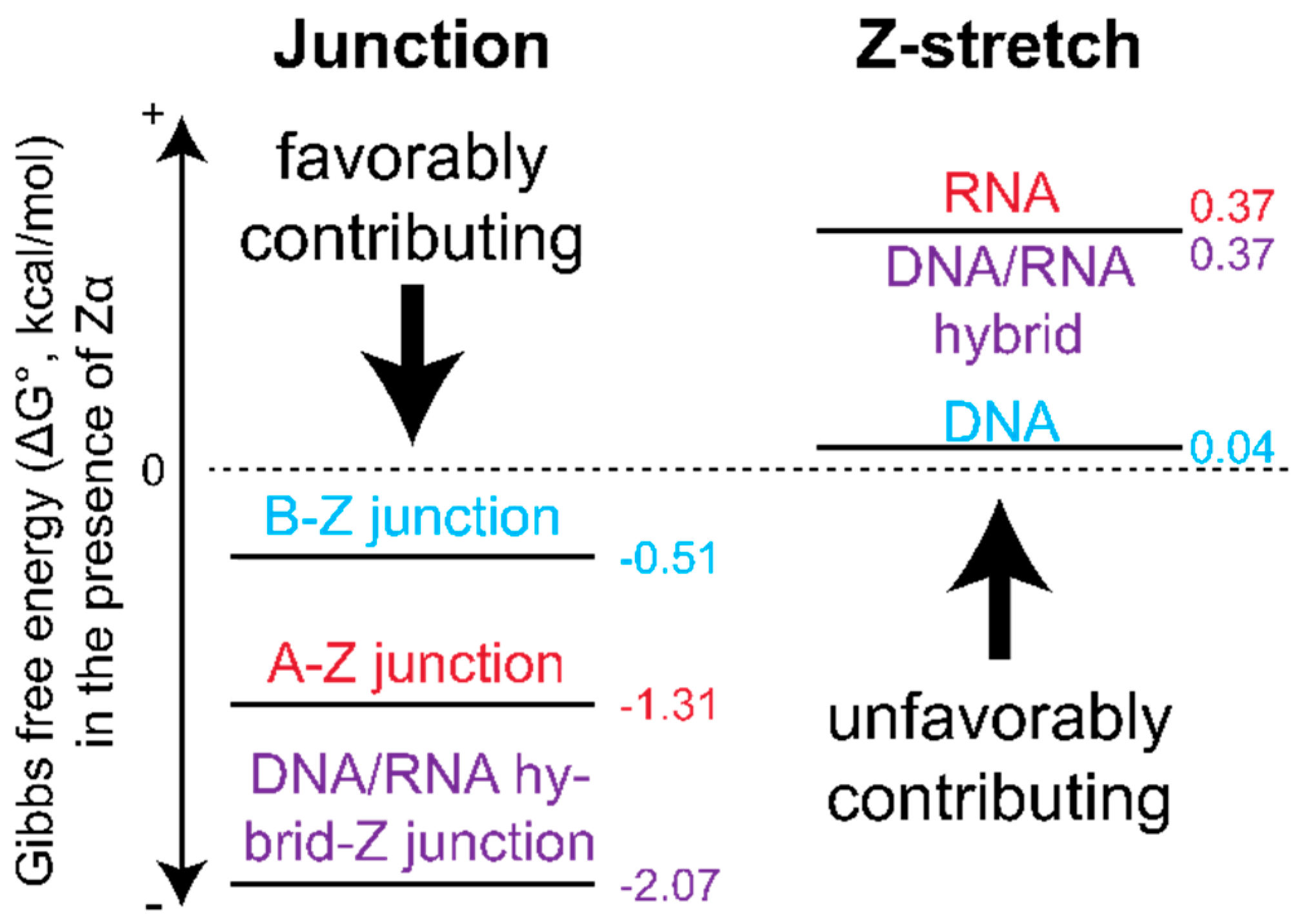
| Helix Sense | B-DNA 1 | Z-DNA (Z1) 1 | A-RNA 1 | Z-RNA (ZD) 2 |
|---|---|---|---|---|
| Right-Handed | Left-Handed | Right-Handed | Left-Handed | |
| Residues per Turn | 10 | 12 | 11 | 12 |
| Pitch Height (Å) | 33.8 | 44.6 | 30.9 | 44.6 |
| Diameter (Å) | 20 | 18 | 23 | 18 |
| Rise per Residue (Å) 3 | 3.38 | 3.7 | 2.81 | 3.7 |
| Base Tilt (˚) | −6 | −7 | 13 | −7 |
| Rotation per Residue (˚) 4 | 36 | −9, −51 | 32.7 | −8.6, −50.9 |
| Nucleoside Conformation | ||||
| Guanosine | Anti | Syn | Anti | Syn |
| Cytidine | Anti | Anti | Anti | Anti |
| Sugar Pucker | ||||
| Guanosine | C2′-endo | C3′-endo | C3′-endo | C3′-endo |
| Cytidine | C2′-endo | C2′-endo | C3′-endo | C2′-endo |
Disclaimer/Publisher’s Note: The statements, opinions and data contained in all publications are solely those of the individual author(s) and contributor(s) and not of MDPI and/or the editor(s). MDPI and/or the editor(s) disclaim responsibility for any injury to people or property resulting from any ideas, methods, instructions or products referred to in the content. |
© 2023 by the authors. Licensee MDPI, Basel, Switzerland. This article is an open access article distributed under the terms and conditions of the Creative Commons Attribution (CC BY) license (https://creativecommons.org/licenses/by/4.0/).
Share and Cite
Krall, J.B.; Nichols, P.J.; Henen, M.A.; Vicens, Q.; Vögeli, B. Structure and Formation of Z-DNA and Z-RNA. Molecules 2023, 28, 843. https://doi.org/10.3390/molecules28020843
Krall JB, Nichols PJ, Henen MA, Vicens Q, Vögeli B. Structure and Formation of Z-DNA and Z-RNA. Molecules. 2023; 28(2):843. https://doi.org/10.3390/molecules28020843
Chicago/Turabian StyleKrall, Jeffrey B., Parker J. Nichols, Morkos A. Henen, Quentin Vicens, and Beat Vögeli. 2023. "Structure and Formation of Z-DNA and Z-RNA" Molecules 28, no. 2: 843. https://doi.org/10.3390/molecules28020843
APA StyleKrall, J. B., Nichols, P. J., Henen, M. A., Vicens, Q., & Vögeli, B. (2023). Structure and Formation of Z-DNA and Z-RNA. Molecules, 28(2), 843. https://doi.org/10.3390/molecules28020843






